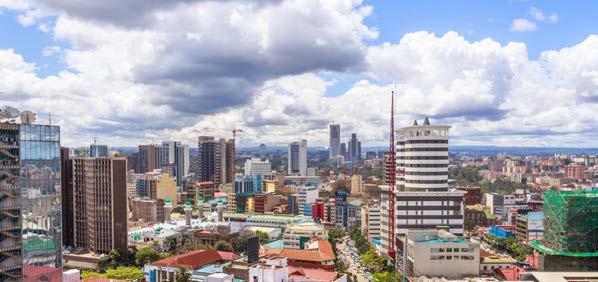
7 minute read
East Africa RIG
Dorothy Maseke, CMIRM, Chair
On the 12th of March, 2020, Kenya became the 11th country in Sub Saharan Africa to confirm its first case of coronavirus. The Government’s response was swift and in a matter of days all public and social gatherings were banned, in-bound travel from high-risk countries was restricted, schools were closed, and within two weeks of the first case being reported, a dusk to dawn curfew was imposed. Shortly thereafter, movement restrictions into and out of high-risk counties, including the capital city, Nairobi, were imposed as measures to contain the spread of the virus. The Government’s response has indeed yielded some fruit, and 55 days after the Coronavirus outbreak was declared a pandemic, Kenya has had 490 confirmed cases, 24 deaths and 173 recoveries. However, the government still faces the challenge of compliance; not all are taking the government directives seriously. Such behaviours could jettison the government’s immediate response which was to delay the spread of the pandemic while giving it time to strengthen its healthcare systems. Like in many countries, the social distancing directives have also been costly to the economy at large, affecting production and demand across most sectors of the economy.
The World Bank, in its latest reports, projects that Kenya’s GDP will decelerate in 2020 with the economic growth projections remaining highly uncertain at the moment. The report predicts a growth of 1.5% in 2020 in the baseline scenarios with a potential downside scenario of contraction to 1.0 % if Covid-19 related disruptions persist. The Central Bank of Kenya also expects GDP growth to contract significantly, revising its estimate for 2020 from the initial 6.2% to 3.4%. Aside from the Covid-19 threat, the horn of Africa is facing an extremely alarming and unprecedented threat to food security and livelihood due to the major locust invasion because it coincides with the early beginning of the long rains and the current growing season. The full impact of the locust invasion to the economy, yet to be fully confirmed and quantified, will only be appreciated at the next harvesting cycle. The effects of the pandemic are not monomorphous. The horticulture and floriculture sector is severely affected due to limited flights and reduced demand in major markets in Europe and Asia. Conversely, the vegetable and fruit exporters are experiencing a surge in demand due to harvesting disruptions in markets in Asia and the Middle East, but they are unable to meet this demand due to the decreased air freight which continues to be a constraint. Horticulture, floriculture, tourism and hospitality are major foreign exchangeearners and these sectors will continue to bear the brunt of this pandemic into the foreseeable future. Sadly, the most affected are the poorest and most vulnerable households. The government has to strike a balance between delaying the virus spread through the enforcement of restrictions while at the same time protecting the vulnerable populations, many of whom rely on small scale agriculture in the rural areas or work within the informal or “jua kali” sector in the urban setting. The informal sector employs over 80% of the Kenyan working population. The numbers reported so far are still relatively low compared to those in the developed world– an indicator that we might be suppressing the curve so far. While the outcome is far better than has been predicted by the various models run by experts, it remains difficult to predict the eventual outcome. What is for sure is that we have been disrupted. Is it all doom and gloom for Kenya? Certainly not! Although Covid-19 brings with it many challenges, it brings with it many new opportunities. Kenya boasts of being Africa’s Silicon Savannah, referring to its vibrant tech ecosystem. With a mobile penetration rate of 91% (compared with Africa’s 80% mobile penetration), internet penetration of 84%, a supporting ICT policy environment and the leading mobile based fintech platform on the continent, M-pesa, it is not a wonder that technology is playing a key role in ensuring resilience in this post-Covid era.
The government has initiated a cash-transfer mechanism to vulnerable households using the leading mobilebased fintech platform. The pandemic has also accelerated digital transformation initiatives within several sectors and industries with work from home and home education becoming the new normal. As pioneers in the mobile-money field, cash-less transfers and digital money is not new to us, and the pandemic has only deepened its adoption. As the effects of the pandemic appear to be subdued, as compared with other regions, there is an opportunity for capital flight to Africa for as long as we can ensure resilience. This subdued impact also presents our government with the opportunity to put our “house in order” and learn from the experience of external markets.
We are in unchartered waters for sure. The extent of the impact of Covid–19 remains greatly uncertain in Kenya, and one is not able to predict what it will look like three or even six months from now. As a matter of fact, the elephant in the room remains this; will the impact of Covid–19 be health-related issues or more on the contagion effect of the economic shocks to the livelihoods of the Kenyan populace. The government, well aware of this, has worked on a raft of economic policies to cushion the vulnerable, and revive the economy when all this comes to an end. What are the key operational considerations for companies in your field? The main operational considerations are premised on two overarching principles. 1. Ensuring the health and safety of staff and other stakeholders 2. Ensuring Business Continuity for operations by taking necessary measures to effectively serve clients and mitigate negative impacts on planned business activities and cash flows Every other process that follows takes into account these two objectives. From my observation, I have noted that a key element of this exists in determining the minimum viable business model and that includes a determination of core processes, products and customer groups. This, in addition to ensuring that the organisation is able to serve the customer and support its staff through the various cycles of change brought about by Covid–19 is paramount. In a world of information clutter, getting out relevant, consistent communication is key to ensure that institutions minimise reputational risks. Acknowledging that indeed there may be difficulties in meeting the optimum operational needs of the businesses due to numerous constraints that the pandemic portends, consistent communication and managing expectations is key. Another important element is the strict health and safety requirements, including social distancing and higher standards of sanitation as well as other emergency response protocols that institutions are now expected to comply with. This goes beyond responsible business practices and established duty of care to now legal and regulatory obligations. Covid–19 should not have come as a surprise to an experienced, trained and qualified risk manager. Although its classification is contentious, it may not in my opinion, qualify as a “Black Swan” event being that such occurrences have taken place in the past and has been researched and documented as case studies in risk management academic material, including the IRM modules. One thing is clear; the risk manager is expected to be a trusted adviser in spite of these unprecedented times. He/she is expected to keep a level head and play an advisory role in a highly uncertainty environment. The risk manager is expected to have mapped out various scenarios and trained its institution on these mostly unlikely and sometimes absurd scenarios. The risk manager is expected to have worked out continuity and resumption plans as they help their institutions build resilience for competitive advantage. After all, good leaders are expected to be prepared to take on the world in all its complexity.
The question to be asked is how did so many of us not see this coming yet over the years, the World Economic Forum has listed the spread of infectious disease as one of the risks in the global risks heat map. Interestingly many did not foresee the impacts that such a pandemic would bring. It should not come as a shock if in the coming years, the environmental and climate change risks that have been long researched, documented and spoken about manifest just as this pandemic. This is a lesson for the future. From what we observe, institutions with well aligned risk management processes and structures are more resilient and will recover faster. The value of a well-coordinated ERM process cannot be underscored in this time.
Covid–19 has indeed increased the visibility of business continuity and resilience professionals. As a result we expect a more receptive audience when speaking on risk management and business resilience issues in future.






